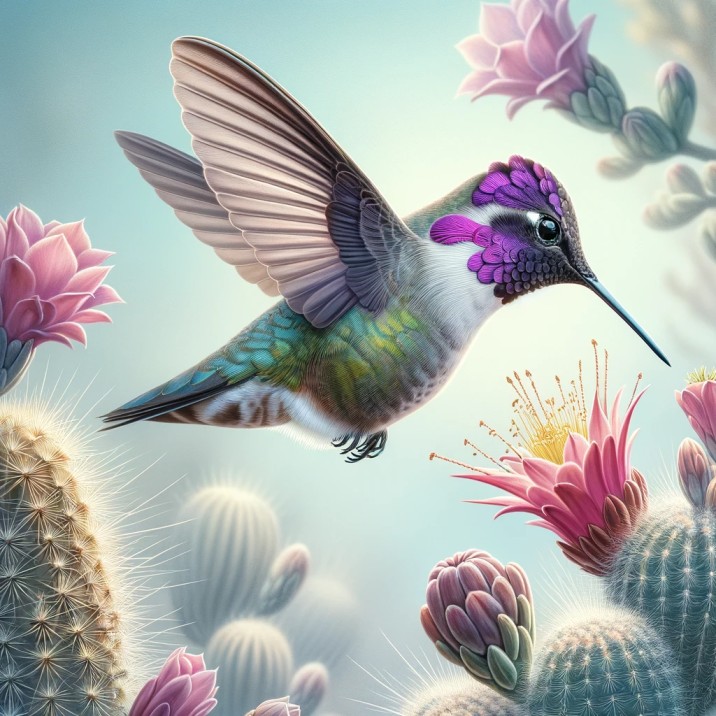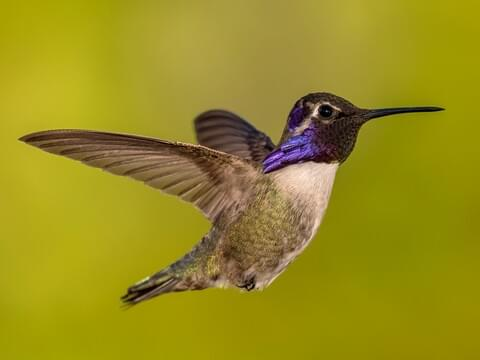The Costa’s Hummingbird, known scientifically as Calypte costae, predominantly resides in the arid regions of the southwestern United States and the Baja California Peninsula in Mexico. These tiny birds are especially adapted to desert environments, showcasing nature’s incredible ability to thrive in seemingly inhospitable conditions.

Habitat and Distribution
The Costa’s Hummingbird favors arid and semi-arid habitats, including deserts, scrublands, and open woodlands. They are commonly found in the Sonoran and Mojave Deserts, extending their range into southern California, western Arizona, and Nevada. During the breeding season, which typically occurs from December to May, they are more prevalent in desert lowlands. Post-breeding, they may move to higher elevations in search of food.
Physical Characteristics
Costa’s Hummingbirds are known for their striking appearance. The males display vibrant iridescent plumage, with a vibrant purple crown and gorget (throat patch), which can appear black in low light. Females and juveniles are more subdued in color, with green upper parts and grayish undersides. They are among the smaller species of hummingbirds, measuring about 3 to 3.5 inches in length.
Behavior and Diet
These birds are agile flyers, known for their hovering ability, which they utilize to feed on nectar from a variety of flowering plants. Their diet primarily consists of nectar from desert plants such as ocotillo, agave, and chuparosa. Insects and spiders also constitute an important part of their diet, providing essential proteins.
Costa’s Hummingbirds exhibit a fascinating courtship display. The male performs a high, steep dive from approximately 100 feet in the air, producing a sharp popping sound at the bottom of the dive, near the female. This acrobatic display is crucial for attracting mates.
Adaptations to Desert Life
Living in the desert, Costa’s Hummingbirds have developed remarkable adaptations to survive in extreme conditions. They can enter a state of torpor at night or in cold weather to conserve energy, significantly lowering their metabolic rate. Additionally, their kidneys are adapted to conserve water, an essential trait for desert survival.
Migration and Breeding
Costa’s Hummingbirds are partial migrants. While some populations are sedentary, others migrate short distances to exploit seasonal food resources. Their migration patterns are primarily influenced by the blooming periods of desert plants.
Their nests are tiny and cup-shaped, often built on branches of shrubs or trees. The females solely undertake nest building and raising of the young. The nest is constructed from plant fibers, spider webs, and other materials, camouflaged with bits of leaves and bark.
Conservation Status
Currently, the Costa’s Hummingbird is listed as a species of least concern by the IUCN Red List. However, they face threats from habitat loss and changes in climate, which affect the availability of their food sources. Urban development and the transformation of desert landscapes pose significant challenges to their natural habitats.
Interaction with Humans
In suburban areas and gardens, Costa’s Hummingbirds often take advantage of hummingbird feeders. Their presence in gardens highlights the importance of preserving native plant species that provide nectar for these and other pollinators.
The Costa’s Hummingbird is a remarkable species, showcasing resilience and adaptability in the harsh desert environment. Their presence is a testament to the diverse and rich life that thrives in arid regions. As with many species, understanding and protecting their natural habitats is key to ensuring their survival and the health of the ecosystems they inhabit. Observing these hummingbirds, whether in the wild deserts or backyard gardens, offers a glimpse into the intricate balance of nature and the importance of conserving these delicate ecosystems.

